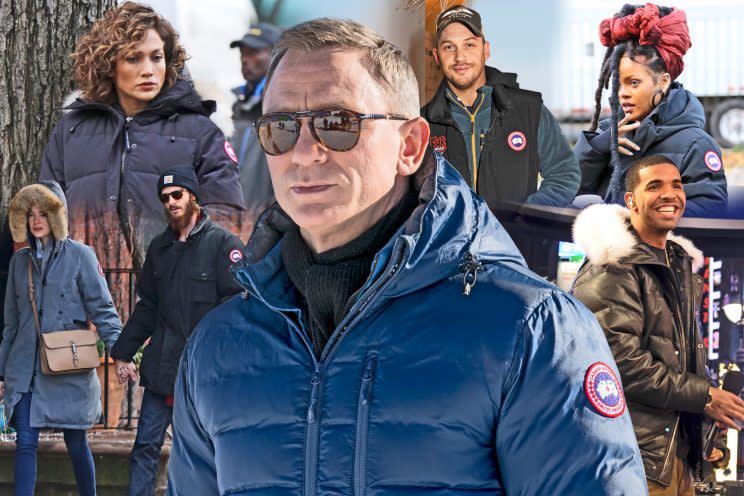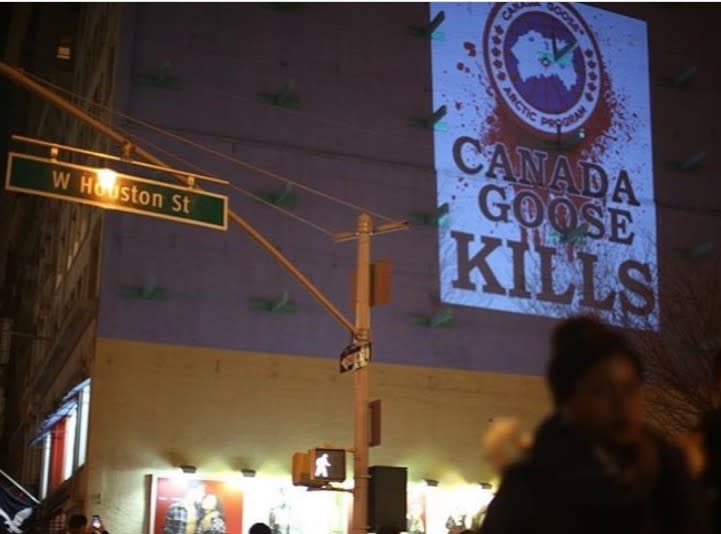Everything You Need to Know About the $900 Jackets Dividing New York City

A flurry of the same, solid-colored winter coats with fur-lined hoods has overtaken Manhattan.
A balmy January hasn’t stopped New Yorkers and the city’s visitors from waddling around in $900 Canada Goose parkas, which are at first glance indistinguishable from other parkas if not for a circular red, white, and blue patch on the arm. While Canada Goose isn’t a new company (it was founded in 1957), it is fast-approaching peak popularity. Google Trends shows that searches for “Canada Goose coats” reached an all-time high in mid-December.
Blame Hollywood for making Canada Goose hypervisible. Filmmakers and actors wear them on movie sets, and Canada Goose is a high-profile sponsor of the Sundance Film Festival (and until recently, was a sponsor of the Berlin Film Festival).
Celebs like Emma Stone, Daniel Craig, Drake, and Rihanna have all been spotted in the parkas, further driving their cool quotient. Celebrities like Ansel Elgort of the Divergent series even attended the company’s New York flagship store opening in November.
In September, Canada Goose revealed a collaboration with Opening Ceremony and, more recently, with Vetements, two brands beloved by streetwear mavens. Though Canada Goose says it doesn’t share its sales numbers as a private company, the jackets are so popular that the company’s website hosts a tool for people to check whether they’re buying an actual Canada Goose parka or a counterfeit.
Celebs and fashion insiders aren’t the only ones hot for the cold-weather coats. Wall Street’s keeping an eye out for an anticipated Canada Goose IPO as soon as February, according to Bloomberg, which also notes the company would be worth $2 billion when it goes public. That puts it on par with what athletic apparel maker Lululemon was worth when its stock went public.
Despite the popularity, not everyone’s on the Canada Goose bandwagon. Displays calling on consumers to boycott the brand have popped up everywhere from New York City subway platforms to London’s Big Ben; Insurgent actress Maggie Q demonstrated against Canada Goose by standing beside a bloodied steel trap outside the company’s Toronto headquarters; and protests and marches are held weekly outside of the SoHo flagship store, the largest of which took place last weekend and attracted about 150 people.

The company says its parkas are the standard-bearer for those braving arctic conditions, with “ethically sourced” coyote fur and down blends, but Rob Banks, an activist who has led the charge against Canada Goose in New York, says those claims are unrealistic.
“They claim they’re an ethical company, but it’s an oxymoron,” Banks says. “You can’t humanely kill an animal. The videos prove it.”
Those videos, which Banks says you can find from a “quick Google search,” graphically show animals struggling to break free from trapping devices. Banks also uses his Instagram account to show them to his 28,000 followers, often juxtaposed with a photo of a celebrity wearing a Canada Goose jacket.
A photo posted by Rob Banks (@rob____banks) on Jan 18, 2017 at 12:04pm PST
In a statement to Yahoo Style, Canada Goose said those videos “misrepresent the facts and use sensational tactics to try to illicit a reaction.” While Banks concedes that the videos don’t necessarily come from fur trappers that Canada Goose uses, he says that all fur-trapping practices are virtually the same.
Ashley Byrne, associate director of campaigns for PETA, echoed Banks’s argument against the company’s practices.
“It’s preposterous to claim coyotes whose legs are ensnared in steel traps for up to 72 hours are being treated humanely,” Byrne said. “Cruelty is found in every stitch of those jackets.”
Canada Goose outlines its guidelines for ethical sourcing and responsible use of fur in a video, abiding by “fur transparency standards,” which are supposed to track exactly where animals used in the coats come from. That is, they’re supposed to come from trappers who abide by the legal standards for trapping and killing.
The fur trade is a $40 billion industry, with its biggest markets in China and Russia. Byrne declined to say how much money or resources PETA devotes to fighting companies like Canada Goose, but said international partners and social media have helped the organization’s cause tremendously.
“[Canada Goose] has billions of dollars, but PETA has footage. Kind people don’t want to support them.”
With the two sides in a standoff, New York is stuck with both Canada Goose enthusiasts and their protesters until the coats migrate to closets in the spring.
Related:
Alexandra Mondalek is a writer for Yahoo Style and Beauty. Follow her on Twitter @amondalek.
Let’s keep in touch! Follow Yahoo Beauty on Facebook, Twitter, Instagram, and Pinterest.

